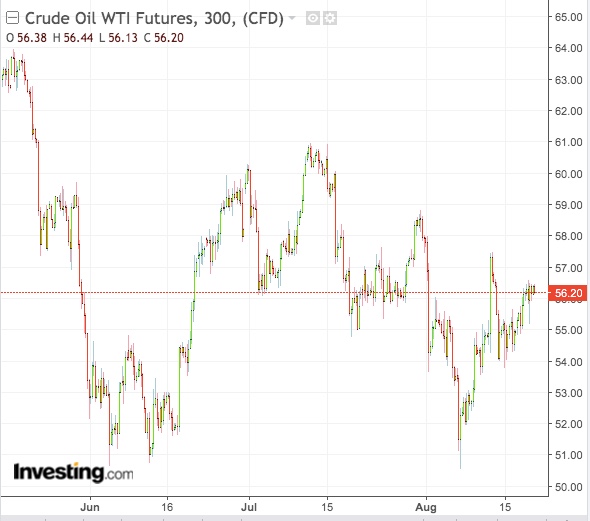Is there hope for large drawdowns in U.S. crude at this point of the driving season?
Since 2019 began, oil markets have experienced some of the most incredible supply outages and geopolitical tensions, which in earlier years might have easily led to three-digit prices.

In reality though, recession fears have frustrated oil bulls from getting their way with prices for most of this summer, trapping U.S. crude in the low-to-mid $50s per barrel and global benchmark Brent under $65.
While progress in U.S.-China trade negotiations and talk of interest rate cuts have been catalysts for price breakouts, the most lasting rallies are often those derived from solid demand numbers for crude. Here's where weekly inventory data from the U.S. Energy Information Administration come in.
Ahead of the EIA's inventory report for the week ended Aug. 16, a preliminary snapshot by trade group American Petroleum Institute showed a 3.5 million-barrel drawdown.
Bulls Will Be Thankful For Any Draw...But The Bigger, The Better
Coming after two prior weeks of stockpile builds totaling nearly 4 million barrels, a drawdown of any magnitude might be met with a silent prayer of thanks by longs in the market.
But to spark—and sustain—a meaningful rally, a drop of 3.0 million barrels or more may be what this market needs.
If the API’s numbers are accurate, it would be proof that refiners’ demand for crude is still surprisingly healthy, given that most analysts had forecast a drawdown of less than 2.0 million barrels for last week. The API also cited a reduction of 2.8 million barrels at the closely-watched Cushing storage hub for U.S. crude in Oklahoma. But inventories of distillates, which include diesel and heating oil, rose by 1.8 million barrels, offsetting some of the positive impact from the data.
The question, of course, is how possible it will be to see confirmation of the drawdowns reported by the API, with just a week left to the peak summer driving demand in the U.S. before the Sept. 2 Labor Day holiday.
History Shows More And Bigger Crude Draws Are Possible
While the variables of each week's supply-demand are unique in their own way, a historical perspective may be helpful.
A year ago, during the week ended Aug. 22, 2018, the EIA reported a crude drawdown of 5.8 million barrels. That’s not all. For the following four weeks, U.S. crude stockpiles continued to see declines, losing a cumulative 14.2 million barrels.
In 2017, U.S. crude draws abruptly stopped in the final week of August before three straight weeks of builds that added nearly 15 million barrels to inventories. But almost all of that was cleared in the successive four weeks, as stockpiles dropped without stop.
If All Fails, It Will Be Left To OPEC To Shore Up The Market
If, for any reason, no crude drawdowns are reported between now and the next couple of weeks, then oil bulls' only hope of shoring up prices will be to bank on more stringent OPEC production cuts.
Saudi Arabia hinted in recent weeks that they and the combined forces in OPEC will do anything to “rebalance” the market: in other words, slash production until they can turn the corner. The cartel remains committed to keeping 1.2 million barrels per day off the market, though the Saudis themselves have often done more.
Yet, some analysts aren’t convinced that OPEC has enough wherewithal to keep this market higher.
Olivier Jakob, founder of the Petromatrix consultancy in Zug, Switzerland, is one of them, arguing that crude stocks were unchanged for the first time since 2016.
He said:
“If Saudi Arabia wants to support stronger balances (prices), then it needs to let crude oil exports drop below 6.5 million barrels per day and towards 6.0 million bpd; something it has refused to do in 2014 or 2017.”
